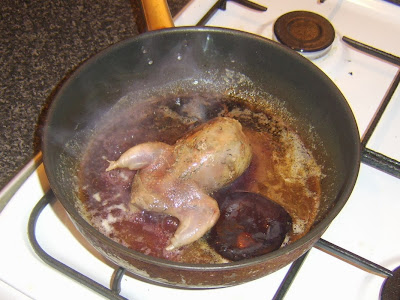 |
| Seared swordfish steak is served on a warm fusilli pasta salad |
Swordfish is a beautiful eating fish, not dissimilar to tuna. It is not however always easy to get hold of and even where it is available, care should be taken to ensure the fish comes from a sustainable source. If you're buying swordfish in the United Kingdom, this is easily checked by looking in your supermarket or fishmonger's for the blue tick of the MSC (Marine Stewardship Council) which signifies compliance with this important factor.
The most important thing to remember when cooking swordfish is that it must never be overcooked. In a similar way to both tuna and salmon, it is served and enjoyed at its best when still slightly pink and ostensibly underdone in the centre. Cook it too much and it will become dry and overly flaky.
 |
| Simple Mediterranean style salad ingredients |
Ingredients per Person
1 swordfish steak
1 medium tomato, seeded and finely diced
2 inch piece of cucumber, seeded and finely diced
3 large basil leaves, finely sliced (2 for salad and 1 to garnish)
1 clove of garlic, peeled and grated
1 tablespoon extra virgin olive oil, plus extra for frying swordfish
Salt and pepper
4 ounces dried fusilli pasta
 |
| Simple salad prepared for fusilli pasta |
Directions
Begin by assembling the salad to give the flavours maximum infusion time. The tomato, cucumber, basil, garlic and olive oil are all combined in a bowl with some seasoning. Cover with clingfilm until required.
 |
| Fusilli pasta |
Bring a large pot of heavily salted water to a rolling boil. Add the pasta, stir well but briefly and simmer for around ten minutes or until al dente.
 |
| Fresh swordfish steak |
When the pasta is almost ready, drizzle some olive oil in to a small frying pan and bring it up to a high heat. Season the swordfish steak on both sides with salt and pepper and lay it in the hot pan.
It is important to watch the swordfish cook if it is to be cooked correctly. The time it will take to cook will depend upon the thickness of the steak. What you are watching for is the steak appearing to have cooked one-third of the way up the side. At this stage, it should be turned to cook a third of the way up the other side. This thin steak required only about one minute on each side.
 |
| Pan searing a swordfish steak |
When the swordfish has been turned, drain the pasta through a colander at your sink and return it to the empty pot. Add the prepared salad and stir well with a wooden spoon. Taste and adjust the seasoning if required before stirring again.
 |
| Salad is added to drained fusilli pasta |
Spoon the pasta in to a deep serving plate to form an effective bed for the swordfish.
 |
| Fusilli pasta salad is plated to form a bed for the swordfish |
Lift the swordfish on to the fusilli bed, scatter with the remaining basil strips and serve immediately.
 |
| Swordfish steak is laid on fusilli pasta salad |


















